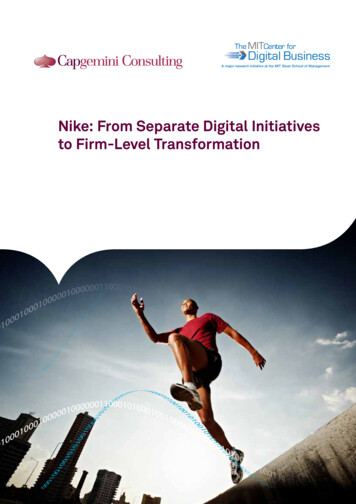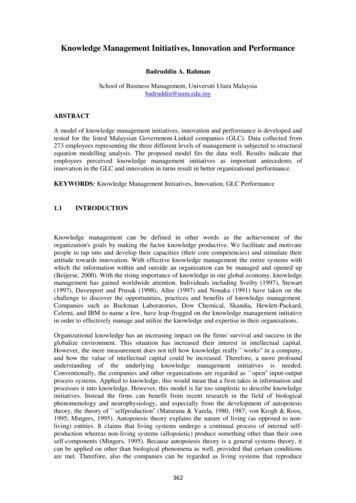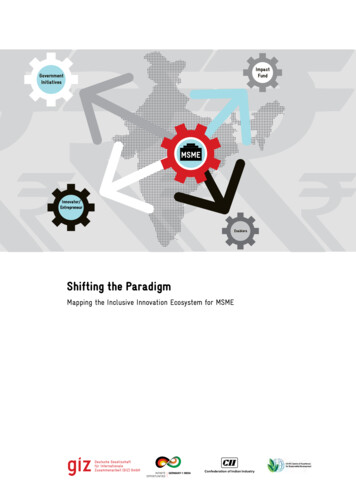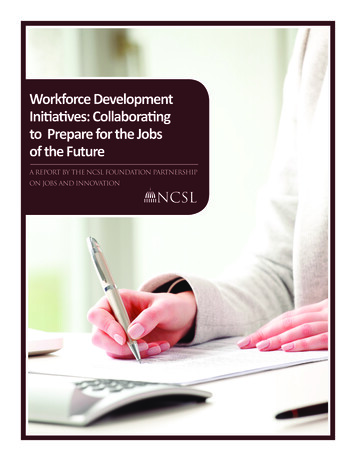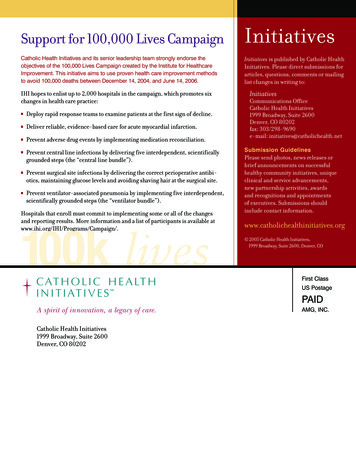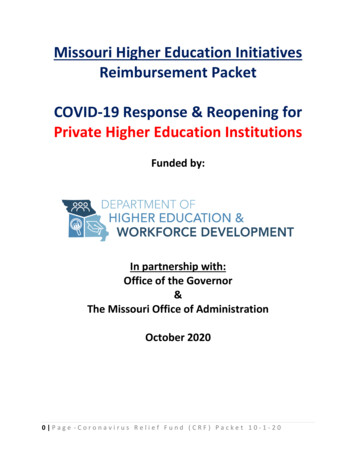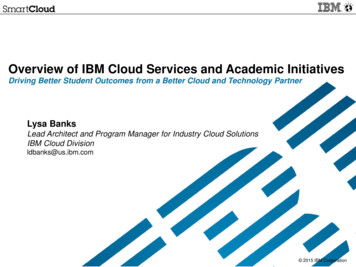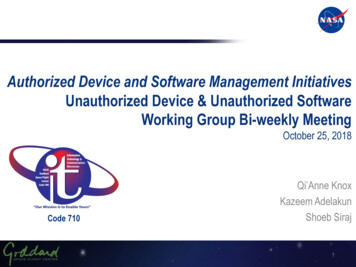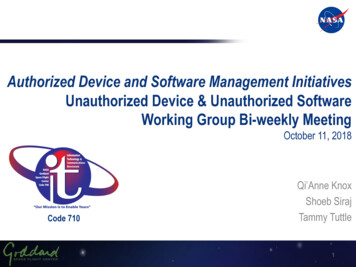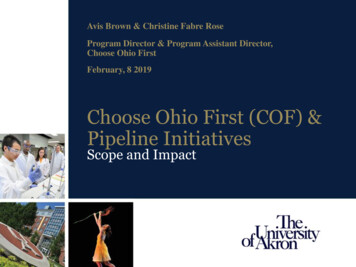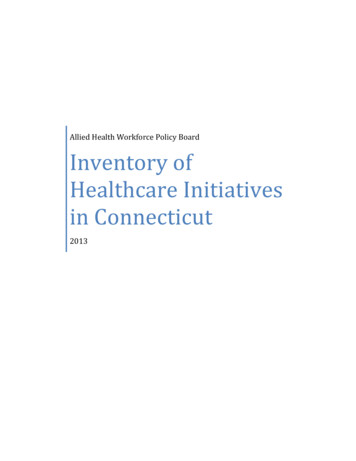
Transcription
Allied Health Workforce Policy BoardInventory ofHealthcare Initiativesin Connecticut2013
ContentsInventory of Healthcare Initiatives in Connecticut . 2STATE AGENCIES. 2Board of Regents for Higher Education . 2Office of Higher Education . 2Department of Public Health. 3PARTNER AGENCIES AND INITIATIVES . 4Connecticut Hospital Association . 41199 Training and Upgrading Fund. 4The Connecticut League for Nursing (CLN) . 5Workforce Solutions Collaborative of Metro Hartford . 8Connecticut Workforce Collaborative on Behavioral Health . 9HIGH SCHOOL INITIATIVES . 10Connecticut Comprehensive High Schools . 10Connecticut Technical High School System . 11COLLEGES AND UNIVERSITIES . 12Community College System: New and Noteworthy. 12CT State University System . 21Charter Oak State College . 29Connecticut Conference of Independent Colleges. 30University of Connecticut . 39University of Connecticut Health Center--Area Health Education Centers (AHEC). 47WORKFORCE INVESTMENT BOARDS. 51Capital Workforce Partners (CWP)—North Central Workforce Investment Board . 51Eastern Workforce Investment Board (EWIB). 52Northwest Regional Workforce Investment Board (NRWIB) . 53Workforce Alliance—South Central Workforce Investment Board . 54The WorkPlace, Inc.—Southwestern Workforce Investment Board. 561
INVENTORY OF HEALTHCARE INITIATIVES IN CONNECTICUTAs healthcare continues to change across the country, there are a number of new and existing initiativesin Connecticut that address the shortage of a skilled healthcare workforce. The following is a list ofinitiatives collected by the Allied Health Workforce Policy Board in an attempt to document programsacross the state. The initiatives are self reported and can be used to provide an overview of both publicand private healthcare workforce programs. This is not an exhaustive list and will be updated regularly.STATE AGENCIESBoard of Regents for Higher EducationThe State of Connecticut Board of Regents for Higher Education was established by the ConnecticutGeneral Assembly in 2011 (via Public Act 11-48 as amended by Public Act 11-61) bringing together theConnecticut State University System, Connecticut Community Colleges and Charter Oak State College.The Board of Regents for Higher Education is composed of 15 voting members; nine appointed by theGovernor; four appointed by legislative leadership, of whom one is a specialist in K-12 education; andthe three remaining are alumni of the Community Colleges, Connecticut State Universities, and/orCharter Oak State College; and the chair and vice-chair of the Student Advisory Committee. On theBoard as non-voting, ex-officio members are the Commissioners of Education, Economic and CommunityDevelopment, Labor and Public Health. The chair of the Board of Regents is appointed by the Governor;the Board of Regents elects a vice-chair and other officers from among its membership.Office of Higher EducationThe Office of Higher Education (OHE), formerly the Department of Higher Education, was establishedduring the reorganization of higher education under Public Act 11-48, resulting in its regulatoryoversight for the independent colleges and universities, non-degree granting occupational schools andhospital based occupational training. For the 2011-12 academic year, the Office of Higher educationworked with the independent colleges and universities on the review, licensure and/or accreditation of17 degree programs in health sciences: 5 associate degree programs, 2 baccalaureate degree programs,5 master’s degree programs, and 5 graduate certificates.OHE also has regulatory oversight for the 89 non-degree granting occupational schools that offer avariety of training programs, many of which focus on allied health programs. An overview of theprograms are as follows: 11 dental assisting, 2 diagnostic medical sonography, 9 practical nursing, 11massage therapy, 7 medical administrative assistant, 13 medical insurance billing and coding, 21 medicalassisting, 20 nurse assistant training, and 3 phlebotomy.2
OHE recently gained oversight for the hospital based occupational training with 6 hospitals currentlyoffering programs in the fields of adult and pediatric ultrasound, general sonography, radiologictechnology, sterile processing, surgical technology and patient care technician.Department of Public HealthThe Department of Public Health has several ongoing programs funded through state and federalallocations that support nursing and allied health professions. The funding and programs include: DPH's online license renewal system for physicians, dentists and nurses has been in place formore than 3 years. Utilization of the online renewal system has increased to approximately 30%of practitioners who are eligible to renew online. DPH continues to work closely with otherstate agencies that are using the eLicense system toward reducing redundancies and gainingefficiencies in the licensing process across agencies with the goal of on-line licensing for alllicensed health care, environmental health and emergency medical services professionals, andthe collection of valuable workforce data that is currently unavailable but critical in identifyingand addressing healthcare workforce shortage issues. 283,550 in federal American Recovery and Reimbursement Act (ARRA) funds from October 1,2011 through September 30, 2013 was provided to the DPH Primary Care Office (PCO) tosupport primary care, mental health and dental health provider recruitment and retentionthrough the National Health Service Corp (NHSC). Previous funding from ARRA enabled theNHSC to expand its programs to provide access to, and improve quality of; primary health carein rural and urban federally designated Health Professional Shortage Areas (HPSAs) andincreased the capacity of the federal loan repayment program for critical healthcareprofessionals. Connecticut utilized the ARRA funding to help support the review of NHSC siteand clinician applications and participate in site visits. Additional funding has become availableto provide support for the retention of ARRA funded clinicians, program evaluation to measurethe effectiveness of retention activities and the impact of ARRA funding on communities,including increased access to primary health services through the recruitment assistanceafforded by the NHSC, and the reduction of health care workforce shortages. There are currently233 approved NHSC sites in Connecticut. 59,000 in federal grant monies was allocated to the DPH Emergency Medical Services forChildren (EMSC) Program to fund pediatric training, including courses and a statewideconference for Emergency Medical Services (EMS) personnel and emergency nurses across thestate. Funds were utilized to provide emergency nurses at trauma designated facilities withinthe state with the Broselow Pediatric Emergency Tape and to develop and hand out pediatricpocket guides to EMS personnel, Connecticut ski patrol and to emergency nurses in non-traumadesignated hospitals within the state.3
PARTNER AGENCIES AND INITIATIVESConnecticut Hospital AssociationIn 2011, CHA launched its Diversity Collaborative, a statewide initiative focused on increasing diversity insenior hospital leadership and governance, improving cultural competence in the delivery of patientcare, and increasing supplier diversity. The Collaborative, fashioned after the Institute for HealthcareImprovement’s performance improvement model, involves the development of teams in each hospital,education and sharing of experiences via webinars, meetings and symposia, data collection via amembers-only website, and access to a variety of resources and experts to assist members in meetingdiversity goals. An example of an ongoing educational program provided by CHA to support theCollaborative is the Cross Cultural and Diversity Inclusiveness Training Series developed and taught bythe Hispanic Health Council.The ultimate goal of the diversity initiative is to address healthcare disparities through leadership thatreflects hospitals’ communities and a workforce that is skilled in providing effective, individualized careto patients from multiple cultures and backgrounds.CHA and its members have begun to explore ways to improve employee wellness and address the healthneeds of the hospital workforce. Through a subcommittee of its board, the Association is consideringparticipation in the Healthier Hospitals Initiative, a national movement linking sustainability andimproved health of staff and patients, and has been in discussion with the Connecticut Department ofPublic Health regarding participation in the CDC’s Diabetes Prevention Recognition Program.CHA continues to convene meetings of over 35 association membership groups that provide a regularforum for the exchange of ideas and information among healthcare leaders with similar responsibilities.Groups such as the Emergency Department Nursing Directors, Laboratory Administrators, RehabilitationServices Managers, Administrative Directors of Radiology and Diagnostic Imaging, Human ResourcesExecutives, Patient Care Executives/Chief Nursing Officers, and others, discuss workforce issues andneeds and periodically meet with faculty from colleges and universities within the state.CHA provides a variety of educational programming to support healthcare leadership developmentincluding a leadership academy for nurse managers, program for new nurse preceptors, healthcareexecutive and patient safety summits, and forum for nurse leaders. The Association continues to holdthe annual Smart Moves Forum on safe patient handling in collaboration with the Connecticut Nurse’sAssociation, LeadingAge Connecticut, The Connecticut Association of Healthcare Facilities, and theConnecticut Association for Home Care and Hospice.1199 Training and Upgrading FundThe 1199 Training & Upgrading Fund is a joint labor/management educational program that providestuition reimbursement, career counseling and academic support for District 1199 members interested in4
improving their basic skills, getting their high school diplomas or pursing higher education. The Fundoffers critical financial resources for entry-level workers in unionized long-term care facilities interestedin personal and professional advancement. In 2012, 46 Connecticut nursing homes that have collectivebargaining agreements with District 1199 contributed to the Fund.In 2012, the Fund partnered with the Adult Education Center of Hartford and New Haven AdultEducation in its high school diploma program. The Fund offered a “Transition to College and Careers”program based on a model operated in previous years in partnership with Vernon Regional Adult BasedEducation. English language and adult education classes have been offered on-site at work to employeeswith assistance from WIBs and community colleges (The Workplace, Inc. and Norwalk CommunityCollege did work in Stamford and Capital Workforce Partners has been a recent partner in the Hartfordarea) and in 2012 “Spanish for the Healthcare Worker” classes were held on-site in two Hartford areanursing homes to help the staff communicate better with their Spanish speaking residents.Several hundred 1199 members receive tuition reimbursement each semester, and approximately 200members participate in adult education classes each year. The Fund has been a partner in severalinitiatives including the Bridges to Health Care Careers program at Capital Community College andCapital Workforce Partners’ USDOL Grant and Robert Wood Johnson grant initiatives. In 2012 the Fundpartnered with MACH (Metro Hartford Alliance for Careers in Healthcare) in helping 1199 membersparticipate in the on-line “Long-term Care Certificate Program” at Charter Oak State College. Otherpartners in 2012 included Stamford Adult Education, LVA-Danbury, and FSW Inc. in Bridgeport.The Connecticut League for Nursing (CLN)CLN is the premier nursing organization within the state that facilitates access to education, resources,and information for entry and professional advancement in the field of nursing. The organization’smission is to promote excellence in nursing education to build a strong and diverse nursing workforce atthe constituent level. CLN provides current information and resources about nursing educationprograms and professional development opportunities available throughout Connecticut and the nation.In 2012, the CLN Board and Staff focused on strengthening the organization by positioning itself as the“go-to resource” for nursing education and accomplishing the following: Implemented a 100% Online RN Refresher Course as the first of its kind to serve nursesthroughout the country that wish to re-enter the nursing workforce. Transformed the contentof the course to incorporate the use of a two virtual hospital experiences thereby eliminatingthe on-the-ground clinical module which has positioned this course to be promoted on anational scale with partners from Charter Oak State College. CLN has secured the“endorsements” from California, Hawaii, New Jersey and Ohio to market the program to theirnurses seeking to return to practice. Offered CLN’s Background Check Services to support students in entering their clinicalexperiences. CLN currently works with: Capital Community College, Central CT State University,5
Gateway Community College, Goodwin College, Southern CT State University and the Universityof Connecticut nursing students to support clinical placements. The Simulated Teaching and Learning Initiative (STLI) Grant supports the preparation ofacademic and practice based nurse educators to integrate high fidelity simulation into teachingand learning. The project integrates the National League for Nursing Simulation InnovationResource Center (SIRC) online courses for nurse educators. Over 1,000 nurse educators withinConnecticut have registered for this project. This initiative is led by Linda Perfetto, VicePresident of The CLN Board of Directors. Participated in the third year of the LPN to RN Fast-Track Initiative conducted at GatewayCommunity College and functioned as a fiduciary for grant funds provided by The Annie E. CaseyFoundation. Secured new grant funds in July 2012 from The Casey Foundation to supportstatewide replication of this initiative beginning with Three Rivers Community College andNaugatuck Valley Community College in the fall of 2012. Completed a grant funded revision & piloting of the CLN LPN to RN Articulation Bridge Coursethat awards college credit to LPNs seeking to continue their education within an RN- AssociateDegree Program. Active participation in the Statewide Connecticut Nursing Collaborative (CNC) joining with 20other Nursing Organizations within Connecticut to follow-up on recommendations outlined inthe RWJ/IOM Future of Nursing Report. Partnered with The Workplace, Inc.’s New Health CareeRx Academy (HCA) to lend nursingexpertise to individuals in career transitions and seeking to enter the healthcare field. CLN willconduct over 20, 3-hour Core Skills Training Workshops, facilitate 20, 90-minute MentoringGroups and engage in numerous one-to-one Coaching Sessions with individuals during 2012. Inaddition, offered a 3-hour Customer Service Workshop to HCA participants based on curriculumdesigned by national expert, Susan Baker. Hosted the 1st Annual Elder Care Summit featuring the NLN Advancing Care Excellence forSeniors (ACES) Curriculum. Developed through a partnership of the National League for Nursingand Community College of Philadelphia and funded by the John A. Hartford Foundation, theHearst Foundations, the Independence Foundation and Laerdal Medical. Connecticut Statewidesupporters include: The Connecticut Association for Home Care & Hospice (CAHCH),Connecticut Association of Health Care Facilities (CAHCF), LeadingAge CT (formerly CANPFA),and Connecticut Assisted Living Association (CALA). Created DO-IT! An E-Portfolio Model to document nursing accomplishments, expertise,presentations and publications. There are pre-populated templates that include:6
Promotion & Tenure; Specialty Re-Certifications including the NLN CNE; ProfessionalDevelopment Activities; Research & Scholarly Work; Educational Accomplishments & MORE! Toaccess the DO-IT! E-Portfolio Tool, go to www.ctleaguefornursing. Upgraded the CLN Website adding valuable resources for nurse educators.(www.ctleaguefornursing.org)CLN works with nurse educators in the academic setting and provides educators with the resources andtools to enhance their educational curriculum, as well as, hosts a forum for deans and directors ofnursing programs throughout Connecticut to address statewide nursing issues. In addition, CLN workswith nursing administrators and managers in the practice setting and offers quality resources andprogramming to help clinical educators proactively promote nursing within their organizations, andassist their nursing staff to enhance their clinical, managerial and leadership skills.On the statewide basis, CLN is at the forefront in addressing the nurse faculty shortage, assisting RNsand LPNs re-entry into clinical practice, collaborating with home care agencies to
nursing homes to help the staff communicate better with their Spanish speaking residents. Several hundred 1199 members receive tuition reimbursement each semester, and approximately 200 . Southern CT State University and the University of Connecticut nursing students to

